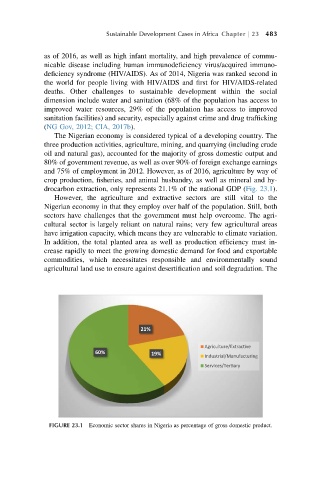Page 514 - Sustainable Cities and Communities Design Handbook
P. 514
Sustainable Development Cases in Africa Chapter j 23 483
as of 2016, as well as high infant mortality, and high prevalence of commu-
nicable disease including human immunodeficiency virus/acquired immuno-
deficiency syndrome (HIV/AIDS). As of 2014, Nigeria was ranked second in
the world for people living with HIV/AIDS and first for HIV/AIDS-related
deaths. Other challenges to sustainable development within the social
dimension include water and sanitation (68% of the population has access to
improved water resources, 29% of the population has access to improved
sanitation facilities) and security, especially against crime and drug trafficking
(NG Gov, 2012; CIA, 2017b).
The Nigerian economy is considered typical of a developing country. The
three production activities, agriculture, mining, and quarrying (including crude
oil and natural gas), accounted for the majority of gross domestic output and
80% of government revenue, as well as over 90% of foreign exchange earnings
and 75% of employment in 2012. However, as of 2016, agriculture by way of
crop production, fisheries, and animal husbandry, as well as mineral and hy-
drocarbon extraction, only represents 21.1% of the national GDP (Fig. 23.1).
However, the agriculture and extractive sectors are still vital to the
Nigerian economy in that they employ over half of the population. Still, both
sectors have challenges that the government must help overcome. The agri-
cultural sector is largely reliant on natural rains; very few agricultural areas
have irrigation capacity, which means they are vulnerable to climate variation.
In addition, the total planted area as well as production efficiency must in-
crease rapidly to meet the growing domestic demand for food and exportable
commodities, which necessitates responsible and environmentally sound
agricultural land use to ensure against desertification and soil degradation. The
21%
Agriculture/ExtracƟve
60% 19%
Industrial/Manufacturing
Services/TerƟary
FIGURE 23.1 Economic sector shares in Nigeria as percentage of gross domestic product.

